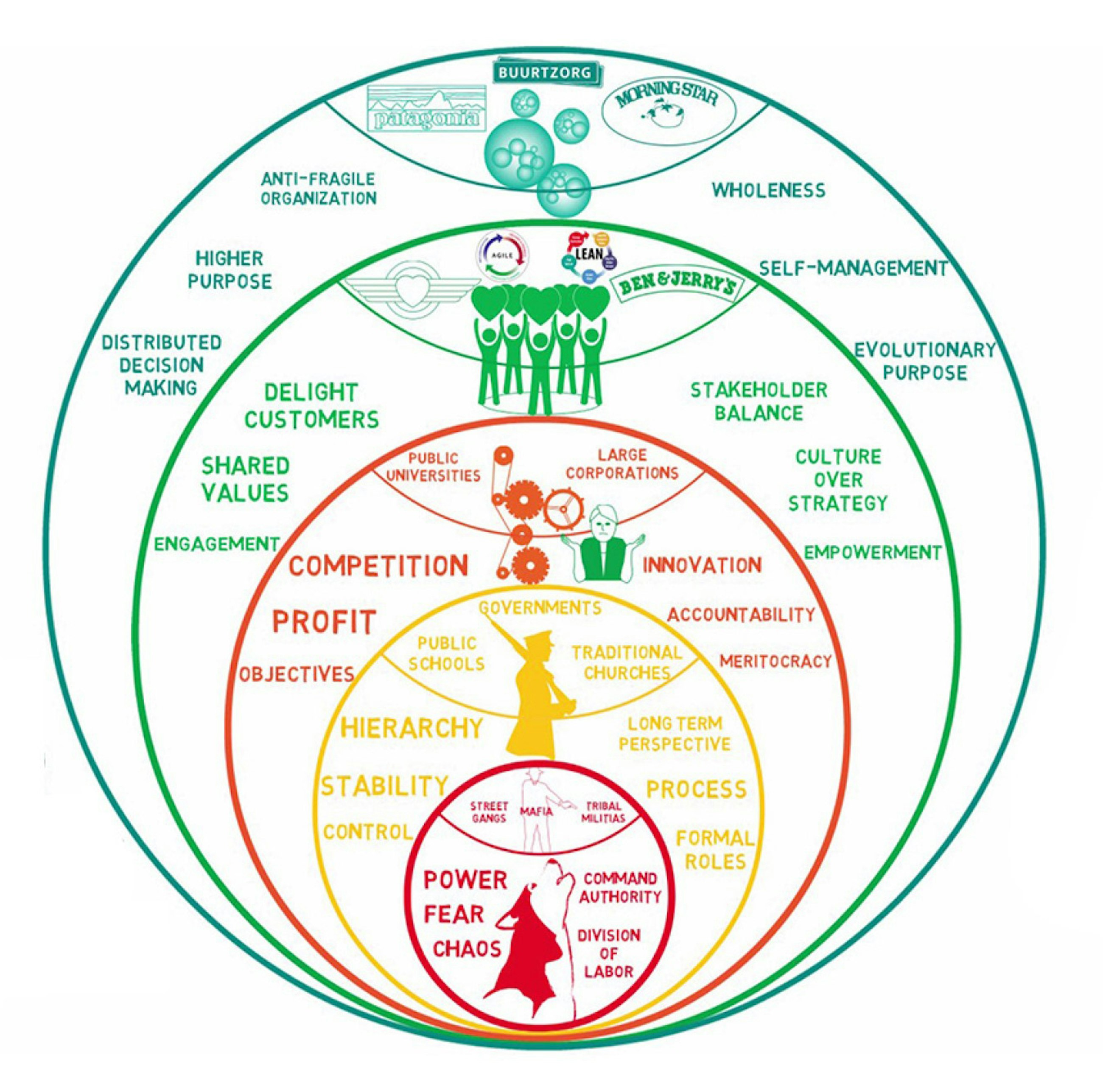– Establishing a powerful, soulful and meaningful organisation for your employees
13 April 2021
In the early 20th century, German sociologist Max Weber (1864-1920) presented his idea of the “ideal bureaucracy” which has been dominant in the way we organise companies and institutions ever since. However, this organisational model is rapidly reaching its expiry date. Bureaucratic organisations are now considered too rigid and too slow to keep up with the pace of change, innovation and employees’ career aspirations. We now see a movement of people driving an evolution of the organisational model which is fostering the birth of agile transformations.
In Implement, we have years of experience implementing new behaviour in organisations. Based on this experience, we have developed a model to support businesses in their journey towards organisational agility. The model consists of five activity tracks that will enable you to transform your business into a more agile organisation.
In this article, we will deep-dive into the second track “People and leadership”. We will go into depth on how “leadership commitment”, “transparency” and “supported autonomy” can enforce the right values and mindset for making your agile transformation sustainable in the long run.
If you would like to read the previous articles, they are available for you here:
Additional reading0 4
Creating organisations that match the conscious development of people
In Implement, we help organisations become fit for the future and fit for humans. We know that there is an unrealised potential to draw on made up of all the talent of those doing the work in organisations. Alongside this, there is much value to gain by having talents who are fully focused on delivering extraordinary value to the customer. We believe that these are benefits we can realise by breaking down bureaucracy and creating more purpose for employees.
Many theorists support the belief that breaking down bureaucracy and creating purpose for employees can release a great potential in organisations, and there has been done extensive research on how organisations can drive the organisational evolution. One theorist, Frederic Laloux, the author of Reinventing Organizations (2014), has presented a framework describing why organisations have changed over time and what new models should look like in the future.
In his framework, Laloux describes five stages of the evolution, where organisations are evolving through coloured paradigms. The first stages are the red ones, then yellow and orange where organisations are mostly hierarchical and bureaucratic and leaders are directing and are perceived as “knowing best”. These organisations will in time evolve towards green and teal organisations driven by values and purpose, where people have autonomy to lead themselves and the role of the leaders is to enable colleagues to perform to their highest capacity.
Laloux’s model is explained and proven through best practice examples ranging from healthcare (Buurtzorg) to clothing (Patagonia) and financial services (Morning Star) (Laloux, 2016). These examples are proof of how new paradigms of organisational development emerge because the former organisational structures are not aligned with the conscious development of humans.
In many ways, organisations of the green and the teal paradigm possess many of the same characteristics of agile organisations, namely a focus on creating customer value, making decisions based on a set of shared values and high engagement from everyone in the organisation. The emergence of these organisations is caused by the employee’s desire to find a more powerful, soulful and meaningful way to work together.
Time and time again, we see how organisations who remain hierarchical and bureaucratic are not able to survive in the future when competing against the next-level organisations. One main reason is that employees are no longer sufficiently motivated by profit and become disparaged by being a small part of a big machine with no real influence over their work. Most importantly, these organisations will not be able to adapt to changing requirements and fail in delivering high customer value.
By adapting your organisational model to become more agile, with higher autonomy for your people and more space for them to “be themselves at work”, your company will not only be faster to adapt to change but also become more powerful, soulful and provide a meaningful way for employees to work together. Sounds cool? Here are our well-proven steps towards a people-driven agile transformation.
People and leadership as the base of your agile transformation
The success of your journey towards organisational agility depends on your people – they have the power to make or break the transformation. You must create a shared desire to transform and ensure the rights conditions for the transformation to be sustainable. People are only as agile as organisations allow them to be, and agile organisations require teams and people who are not only capable of but also able to work in an agile way.
If agile organisations were a sauce, the agile ways of working are the spices that give the sauce its flavour. However, the base is the agile people and agile leadership approach. Mindset and values are the driving force of your agile transformation.
There are three forces that play a vital role in enforcing the right values and mindset for your agile transformation to be sustainable in the long run:
- Leadership commitment
- Transparency
- Supported autonomy
Here is what you must do differently along with concrete examples of how it works in real organisations.
Leadership commitment
The first step in an agile transformation is to get involvement and commitment from leaders across the organisation. As organisations are breaking down bureaucracy, we see a cultural shift, giving value to the term “to empower”. Here, many organisations are moving towards distributed authority rather than one single leader. We argue that informal networks help employees create and find more value, and that the formal structures in organisations belong to lost time.
In a classic bureaucracy, responsibility for both strategy and operations is entrusted to the management level, where, in an agile organisation, the manager will shift their focus to the strategic level, and employees will take leadership of running operations. The change requires a strong partnership between leadership at a strategic and operational level. Leadership commitment is thus not just vested in the top management layer – it is also a commitment from the employees to take leadership. Failing to build commitment from either side will slow down the transformation, and it will be harder to get commitment from the entire organisation if certain groups are downplaying or working against the new model.
A change towards network-based organisations requires leaders who are committed to change and leaders who understand the necessity of letting go of some of the operational power and are willing to pass it on to the people. The leaders must step down the ladder so employees can step up. In order for this to happen, the employees need to be motivated to step up, and a crucial part of this is to help employees understand that they have autonomy and decision power.
In Implement, we do our best to practise agile leadership every day, for example with the “choose your own leader” rule. This allows employees to take responsibility for their own development by individually selecting who they want as a leader with whom they establish an agreement in terms of how they would like to be led for the coming year. Leaders are free to accept or decline any requests and thus choose their own followers as well. In this constellation, leadership is a partnership between leader and follower where each part is committed to making it work. If the employee would like to develop in a different direction the next year, expand their network or simply wants a new perspective on their development they are free to choose a new leader the next year.
Another example of great leadership commitment is from Nucor, an American steel production company founded in 1940. Here, power is pushed far down into the organisation, and every single important decision is made by each individual division – and the general manager of the division is accountable for those divisions. This means that plant areas are operated as independent enterprises. Each division/plan takes care of all tasks all the way from producing raw materials, designing marketing strategies, setting production quotes and even taking care of hiring, training and managing their own workforce. Such a setup could never work if leadership was not committed to decentralising decision power and employees were not committed to taking it.
In short, to establish leadership commitment in your organisation, you must:
- Train and prepare leaders to practise servant leadership.
- Embed leadership in roles on all levels of the organisation.
- Push accountability from the manager level towards team level.
Transparency
In an agile transformation, transparency and trust go hand in hand. Being transparent ensures that you communicate intensely with the organisation. To do this, you must establish a high level of transparency regarding the transformation and involve the employees throughout (for example through sounding boards or hackathons). Build trust by creating transparent, inclusive ways to gather feedback and gain alignment on how your organisation wants to work in the future. Let your employees know what the end-step transformation looks like – moving from uncertainty in the process and many worries from the employees to a finished result where the employees feel happy and safe about the agile transformation.
During agile transformations, it is especially important to have a transparent career model. Be transparent about career development and salary. Make sure that all employees know what is needed to advance in their career and what the pay levels are – not just at the current state but also how the career model will look in the agile transformation.
In Whole Foods, transparency is practised through wage transparency. The average pay of professional titles alongside performance data for every team in every store is made widely available across the entire company. Furthermore, teams receive information about their profit per labour hour every four weeks as well as their historical performance, the performance of other teams in their store and the performance of similar teams in other stores.
To enhance trust through transparency in the transformation, you should consider the following:
- Communicate what the end state of the transformation looks like for all levels of the organisation.
- Be clear about what the transformation entails for career development and what is needed to advance your career.
- Practise “wage transparency” for average pay of professional titles.
Supported autonomy
Finally, a transformation means designing a new organisational setup, which means adjusting the current roles and responsibilities. This entails transforming the existing HR model to a new one with all the elements that this includes (e.g. career progression, titles, roles and responsibilities etc.). Here it is important to develop new competences for the people in your organisation by training your employees to step up and take on more and more responsibility. We recommend that you invite employees into the planning sessions and include them in discussions on which targets make sense to them, and which targets they wish to be measured on.
Our experience shows that the talents of your organisation will easily adapt to having more autonomy. Most of them will even welcome it. However, there are many employees who are not naturally attracted to having a lot of responsibility. These are the groups you must focus on training and providing support to, for example through a combination of role-specific training sessions and direct coaching in teams.
When it comes to autonomy, there is no such thing as leapfrogging. You must take small steps and make sure that everyone in the organisation is on board. Provide a safe space for training and build competences and trust simultaneously.
Buurtzorg, which is a Dutch homecare organisation, has been extremely successful using independent nurse teams for delivering relatively low-cost care. The organisation consists of mixed teams who are assigned to specific regions where they are held responsible for the performance and quality of all services and patients within their region. The self-organising teams decide on what they do for patients, on who works when and on who goes to which patient. They are asked to increase and decrease their capacity to reach goals. This includes decisions on hiring and firing*. Most importantly, these teams are supported by a coach. Each coach is supporting up to 40 teams. This requires that the coach is focused on helping the teams rather than being focused on themselves. The coaches do this by leveraging their experience and background of previously being nurses themselves.
To develop and support autonomy in your organisation, you must:
- Identify groups in need of role-specific coaching and provide a safe space for training.
- Invite employees into planning sessions and include them in target discussions.
- Hire coaches who are focused on supporting teams, preferably with experience within the specific field of the teams.
The change journey starts with a readiness assessment
Concluding this article, we’ll give you the first small steps for you to start your agile journey.
The agile transformation must start with a readiness assessment to clarify whether your employees are used to stepping up, being autonomous and taking responsibility for driving tasks. And whether your leaders are equally capable of stepping down and giving away power to the employees. These factors are crucial for your agile transformation – in fact, you are looking at two completely different types of transformations depending on where on the spectrum you are as an organisation.
A readiness assessment will take its departure in two main assessments: how steep and integrated is the current hierarchy of your organisation, and how capable are your employees in terms of stepping up the ladder of autonomy.
These factors will define the organisational ambition level and transformation path and can help you define the appropriate support and training for your employees and leaders.
Sources
*https://implementconsultinggroup.com/unleashing-people-potential/
Laloux F. (2016): Reinventing Organizations: An Illustrated Invitation to Join the Conversation on Next-Stage Organizations, Millis MA, Nelson Parker.
Laloux, F. (2014): Reinventing Organizations: A Guide to Creating Organizations Inspired by the Next Stage of Human Consciousness, Brussels: Nelson Parker.







